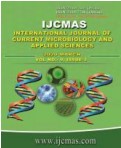


 National Academy of Agricultural Sciences (NAAS)
National Academy of Agricultural Sciences (NAAS)

|
PRINT ISSN : 2319-7692
Online ISSN : 2319-7706 Issues : 12 per year Publisher : Excellent Publishers Email : editorijcmas@gmail.com / submit@ijcmas.com Editor-in-chief: Dr.M.Prakash Index Copernicus ICV 2018: 95.39 NAAS RATING 2020: 5.38 |
Genotype-environment interaction and stability performance were investigated on twenty genotypes of bio-fortified red kernel rice in three environments, at the experimental farm of Agricultural Research Station, Shirgaon, Agricultural Research Station, Phondaghat and department of Agricultural Botany farm, Dapoli (M.S.) during Kharif 2016. In interaction principle axis of AMMI biplot, first interaction principle axis (IPCA I) are favorable for all characters but second interaction principle axis (IPCA II) are favorable for eight characters In AMMI 1 biplot, Dapoli location (E3) favorable six for characters, Phondaghat location (E2) favorable for three characters and Shirgaon location (E1) favorable for eight traits Both AMMI 1 and AMMI 2 biplot analysis was performed for grain yield plot-1 since mean square for the IPCA I and IPCA II were found to be significant. AMMI 1 Biplot revealed that, genotypes, Bela and RTN-1211-6-1-4-1-11(6) fell almost on the horizontal line indicating uniform grain yield plot-1across the three environments. In AMMI 2 biplot Dapoli had short spoks and they did not exert strong interactive force while environments, Phondaghat and Shirgaon having long spoks exert strong interaction. Genotypes viz., RTN-1201-51-2-1-5-48, RTN-1211-5-1-3-5 and RTN-1201-5-1-3-14 were stable for Shirgaon and Dapoli environments for the traits viz., grain yield plant-1, grain yield plot-1, protein content (%), zinc content (ppm), iron content (ppm), amylose content (%), genotypes viz., RTN-1201-51-2-1-5-48 and RTN-1211-6-1-3-1-8 were stable for Shirgaon environment only, while as genotype RTN-1201-13-2-2-1-32 was stable for for all yield contributing characters across the three environments. The stable Genotype, RTN-1201-13-2-2-1-32 could be commercially exploited after testing in state multilocation and national trials or may be utilized for further studies
 |
 |
 |
 |
 |